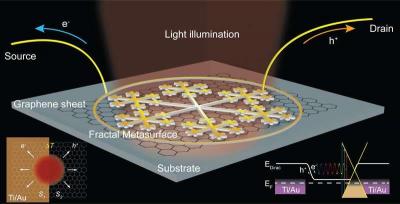Researchers from Purdue University in the U.S have shown that a snowflake-like fractal design (in which the same pattern repeats at smaller and smaller scales) can increase graphene's inherently low optical absorption. This could lead to graphene photodetectors with an order-of-magnitude increase in photovoltage, along with ultrafast light detection and other advantages.

Graphene has an intrinsically low optical absorption, which is a major drawback for use in photodetectors. To address this issue, the Purdue researchers designed a graphene photodetector with gold contacts in the form of a snowflake-like fractal metasurface. They demonstrated that the fractal pattern does a better job of collecting photons across a wide range of frequencies compared to a plain gold-graphene edge, enabling the new design to generate 10 times more photovoltage.
The research team explained that these characteristics can be directly attributed to the fractal pattern: "Our proposed fractal metasurface has the unique ability of supporting plasmonic resonances (free electron oscillations) over a wide spectral range in a polarization-insensitive way due to its complex and highly hexagonally symmetric geometry," the team said. "Previously reported plasmonic-enhanced graphene photodetectors use simpler narrowband and polarization-sensitive structures, and therefore the enhancement is also narrowband and polarization-sensitive."
As previous research has shown, the reason that a fractal pattern can improve optical absorption is that the fractal metasurface creates additional resonances, with the amount of resonance increasing as the number of fractal levels increases. In addition, the researchers here found that the fractal metasurface confines and enhances the electric field of the light that hits the surface. This ultimately leads to a higher photovoltage generated in the graphene photodetector.
There are two major mechanisms of inducing photovoltage in a graphene-based photodetector: the photovoltaic effect and the photothermoelectric effect. The photovoltaic effect uses the built-in electric field induced by differently doped regions in graphene to separate the optically excited electron hole pairs in graphene. The photothermoelectric effect drives the free electrons in graphene across regions with different thermoelectric powers (Seebeck coefficients), given a temperature gradient in between the two regions.
The fractal metasurface enhances both effects in graphene photodetectors by increasing the electric field intensity and by heating via incident light in highly confined spaces.
In the future, the researchers plan to explore the potential applications of graphene photodetectors, which could extend beyond photodetection to photoharvesting, with applications such as solar cells and optical heating. Technologies that require a fast response could also experience significant improvements due to the graphene photodetector's fast operation speed.

